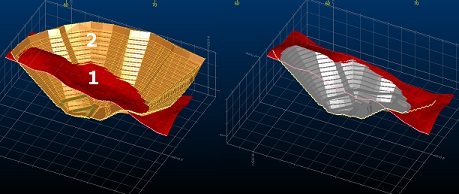|
|
Command Help |
|
Command Name |
Menu |
Quick Key |
Link to Command Table |
|
wireframe-surface-merge-intersecting |
- |
Description
Surface operation to update one wireframe DTM surface with another, using the Update DTM dialog. Either full objects or selected wireframe triangles can be set as DTM inputs to this command.
This command differs from wireframe-surface-merge (Update DTM) in that it assumes a clean intersection of both DTM surfaces exists. If you are confident that both surfaces intersect cleanly/fully, this command will be able to offer a performance improvement over wireframe-surface-merge for the same data inputs.
How to use
Generate a new surface using the second wireframe (or selected data) to update the surface elevation in preference to the first. The resultant surface area is the union of the first and the second wireframe surface/selected data, so there is no restriction that the second surface be bounded by the first.
The operation of the command can be likened to using a cookie cutter at the boundary of the second surface data to cut out the first surface data, and inserting the second surface into the first. No attempt is made to close gaps between surfaces and if such gaps occur, so may unexpected results.
Provided the second surface is bounded by the first the cut and fill wireframe solids can be generated by projecting the two surfaces with the wireframe-surface-project command to an elevation beyond the range of the two surfaces, and then completing wireframe- difference and wireframe-intersection operations on these surface solids as follows:
-
project the first surface down to the lower elevation (A)
-
project the second surface down to the lower elevation (B)
-
project the second surface up to the upper elevation (C)
-
create the fill wireframe as the difference B minus A
-
create the cut volume as the intersection of C and A
If the surface bounded by one or more closed strings is required, this can be found by the following sequence of operations:
-
project the strings up and down to elevations beyond the range of the surface
-
link the upper and lower strings into a single wireframe group
-
intersecting the original surface with the string surface(s) using the wireframe-merge command
-
delete the string wireframe surfaces, and the components of the original surface within or outside the strings as required.
If instead of the complete result of the wireframe-surface-merge command it was sufficient to replace the first surface with the second in the region of overlap then the wireframe-verify command could be used to generate the boundary string at the limit of the second surface, and then the previous command sequence could be used to do the cookie cutter operation on the first surface before adding the second. The surfaces are not guaranteed to be coincident on the boundary with this method.
Note: This command supports flexible wireframe selection.
|
|
Related Topics |
|
|
Boolean
operations wireframe-surface-merge |


